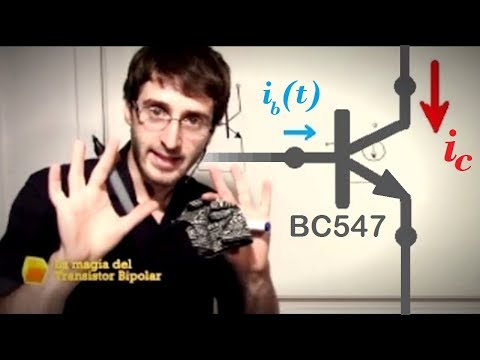The BJT Transistor Symbol: Complete Guide and Meaning
The bipolar junction transistor (BJT) is one of the most important components in electronics. Its symbol is universally recognized and its meaning goes beyond a simple graphic representation. In this article, we will thoroughly explore the BJT transistor symbol, unraveling its structure and discovering its meaning in the world of electronics. If you've ever wondered what each element in the BJT transistor symbol represents, you're in the right place. Get ready to dive into a complete guide and reveal the secrets of this essential component!
What does a BJT transistor mean?
The BJT Transistor Symbol: Complete Guide and Meaning
BJT transistors, also known as bipolar junction transistors, are key components in modern electronics and technology. Its symbol is a graphic representation that helps us understand its operation and its connection in circuits. In this article, we are going to explore in depth the meaning of the BJT transistor symbol and how to interpret it correctly.
The BJT transistor symbol consists of three main parts: the base, the emitter and the collector. These parts are connected to each other through PN junctions, which are the junctions between P- and N-type semiconductor materials. The base is the central part of the symbol and is represented by an arrow that indicates the direction of current. The emitter is the left part of the symbol, while the collector is the right part.
To better understand the meaning of the BJT transistor symbol, it is important to understand the basic operation of this component. BJT transistors are three-layer devices, composed of a layer of P-type material, a layer of N-type material, and another layer of P-type material. These layers are called emitter, base, and collector, respectively.
When a current is applied to the base terminal, it creates a flow of electrons from the emitter to the collector. This is due to the configuration of the PN junctions and the amplification effect of the transistor. The current flowing through the BJT transistor is controlled by the base current. A small base current can control a much larger current flowing through the collector.
The BJT transistor symbol is a visual representation of how the different parts of the transistor are connected in a circuit. The arrow on the base indicates the direction of current, while the relationship between the emitter and collector is shown by the relative position of these parts on the symbol.
It is important to note that there are different types of BJT transistors, such as NPN and PNP transistors. The main difference between them lies in the polarity of the PN junctions and the direction of the current. The BJT transistor symbol may vary slightly depending on the type of transistor, but the basic structure and general meaning remain the same.
What does the NPN symbol mean?
The NPN symbol is one of the most commonly used symbols to represent a bipolar junction transistor (BJT). This symbol, made up of three layers, represents the internal structure of the transistor and provides essential information about its operation.
The meaning of the NPN symbol is based on the letters N and P, which represent the two types of semiconductor material used in the transistor. The letter N refers to N-type material, which has a large number of negative charge carriers called electrons. On the other hand, the letter P represents P-type material, which has a large number of positive charge carriers called holes.
The NPN symbol consists of three distinct regions: the emitter, the base, and the collector. The emitter is represented by an arrow indicating the direction of electron current flow. The base is located in the center and is connected to the emitter and collector through two perpendicular lines. The collector is located at the opposite end of the emitter and connects to the base via a straight line.
The internal structure of the NPN transistor consists of two PN junctions: the emitter-base junction and the base-collector junction. These junctions are crucial for the operation of the transistor. When an appropriate voltage is applied between the emitter and the base, a current of electrons is created that flows from the emitter to the base. This current of electrons controls the current that flows from the collector to the emitter, thus allowing electrical signals to be amplified and controlled.
The NPN symbol is widely used in electronic circuits, especially in amplifiers and switching circuits. Its design allows for current and voltage amplification, making it a fundamental piece in many electronic devices.
What type of transistor is the BJT?
The BJT Transistor Symbol: Complete Guide and Meaning
The BJT (Bipolar Junction Transistor) transistor is a key component in the world of electronics. It is widely used in electronic circuits to amplify and switch electrical signals. In this article, we are going to explore the BJT transistor symbol, its meaning and how to interpret it.
The BJT transistor symbol consists of three main elements: the base, the collector and the emitter. These elements are represented by arrows and lines in the symbol. The direction of the arrows indicates the polarity of the transistor, while the lines represent the internal connections of the transistor.
The inward-pointing arrow at the base indicates that current flows inward at this terminal. The outward pointing arrow on the collector indicates that current flows outward from this terminal. Lastly, the outward pointing arrow on the emitter indicates that current flows outward from this terminal.
It is important to note that the BJT transistor symbol may vary depending on the type of transistor used. There are two main types of BJT transistors: the NPN transistor and the PNP transistor. The difference between these two types lies in the polarity of the transistor elements. In the NPN transistor, the base and emitter are N-type (negative), while the collector is P-type (positive). In PNP transistor, the base and emitter are of type P (positive), while the collector is of type N (negative).
Here is a table that summarizes the differences between NPN and PNP transistors:
| NPN transistor | PNP transistor |
|---|---|
| negative base | positive base |
| Negative emitter | positive emitter |
| positive collector | negative collector |
And there you have it! Now you are an expert in the mysterious world of BJT transistor symbols. No more confusion, no more unanswered questions. Now you can brag to your friends about your new electronics knowledge. Don't let the BJT transistor catch you off guard!




Post Comment